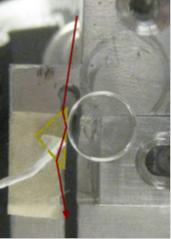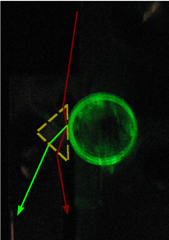Nonlinear Optics in Whispering Gallery Mode Resonators
The reliable and efficient generation of an electromagnetic
Our research program explores the potential for using high-Q crystalline whispering gallery mode resonators (WGMRs) to accomplish low-threshold nonlinear frequency conversion. Such cavities support the modes of light traveling along the circumference of a polished disk (or sphere) through total internal reflection (TIR). Because no actual mirror is used, extremely high quality factors can be achieved in WGMR. Theoretically, the lifetime of a photon inside the cavity is limited by the scattering on the impurities. This limit depends on a crystal, but generally the quality factor ranges from 109 in LiNbO3 to over 1013 in CaF2. More realistically, the Q-factor of a microresonator is limited by the quality of surface polishing. The efficient coupling of laser radiation in a WGM in a crystalline disc is possible by means of frustrated total internal reflection in a coupling prism, as shown in Figure 1. If the rim of a disk is close enough to the reflecting surface of the prism, an evanescent wave tunnels across the gap and that light excites one or several WGMs. It is crucial that the index of refraction of the prism is higher than that of the disc, and thereby the optical coupling is achieved at the critical angle. Rutile with its high refractive index makes a perfect material for coupling to most nonlinear crystals.
The quality factor is a measure of the lifetime of energy stored in the cavity - the longer the lifetime, the more energy can build up in the cavity. For a very high-Q cavity even a low input light intensity can turn into a very intense field in the resonator. For example, a WGM cavity with a Q-factor of 1010 will support a photon for a millisecond (10-3 s), and that is significantly higher than the round trip time (typically in nanosecond scale). In our experiments we have achieved the quality factor of 107 as shown in Figure 2. Significantly higher values will be achieved with improved polishing. This long cavity lifetime combined with small mode volume makes the crystalline WGMR attractive for the quantum optics applications. In particular, we are interested in observing narrow-band low-threshold second-harmonic generation as a first step toward the generation of heralded single photons. Our ultimate goal is to produce high-quality WGM discs that convert a laser light at 795nm to 397nm and vice versa, since 795nm is the wavelength of the D1 spectral line in Rubidium. Such non-classical light will be organically integrated with the atomic quantum memory and slow light experiments conducted by our group. However, as the first step we are practicing polishing LiNbO3 disks and observing nonlinear conversion of 1064nm pump laser light into 532nm second harmonic, since it is possible to achieve non-critical phase-matching (i.e. the matching of the refractive indices for the fundamental and doubled optical frequencies) by tuning the temperature of the nonlinear material, as shown in Figure 3. The pump and generated fields are orthogonally polarized, and thus the dicroic rutile prism offers additional benefit for separating them, as they couple out of the WGM disc at significantly different angles. |




